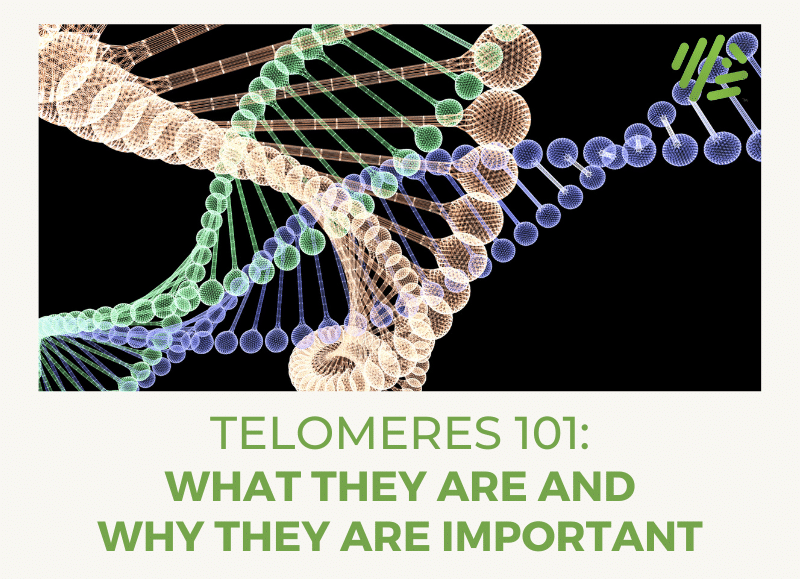Do Long Telomeres Mean a Long Life?
Article at a Glance
- Telomeres are structural ‘caps’ at each end of a chromosome. You can think of them as “helmets” that protect our essential DNA.
- There are numerous studies on both sides of the fence debating whether telomere length is significantly associated with mortality and age-related diseases.
- The link between long telomeres and long life has largely been overhyped.
Genes Mentioned

Contents
Protecting our DNA sequence from damage or degradation is essential to stay healthy for as long as possible.
While each cell in our body contains numerous mechanisms to prevent DNA damage; today I’m going to talk about the role of a structural feature of our chromosomes, called telomeres, and importantly how they are associated with aging and longevity.
Telomeres play a big role in protecting our DNA as we age.
Telomeres are “helmets” for our DNA
Telomeres are structural ‘caps’ at each end of a chromosome. You can think of them as “helmets” that protect our essential DNA.
Each telomere is comprised of a short repetitive sequence of DNA bases (…TTAGGG…) which is repeated thousands of times. This repetitive sequence doesn’t encode for any genes but has important structural functions including preventing the ends of the chromosomes from fusing with one another, helping to organize the chromosomes in the nucleus of the cell and, importantly, protecting against loss of important DNA sequences required for normal cellular processes. 1
- Every time a cell divides, on average, a few hundred bases are lost from the ends of the chromosome as they replicate.
- Telomeres form a buffer so we don’t lose “essential DNA.” Because there are thousands of bases of the repetitive telomere sequence, this sequence is lost instead of important DNA sequence encoding genes.
- Without telomeres, every time a cell divided, whole genes could be lost, losing critical pieces of the genetic code.
- When the telomere becomes short enough that a chromosome reaches a ‘critical length’ (where further cell replication could result in loss of gene sequence), cell division stops, and the cell becomes ‘senescent’ (no longer divides) or undergoes cell death.
So it could be said that telomeres provide ‘genomic stability’, 1 but also that their length can be indicative of the relative age of a cell. This is why many startups have equated telomere testing as an “age clock” that tells us our true biological age.
Telomere maintenance
As telomere length is so key in cell survival, a specific enzyme known as ‘telomerase’ exists which functions to maintain telomere length after cell division. Telomerase adds the lost TTAGGG repeat sequence back onto the ends of chromosomes maintaining their length, which is nicely shown in the image below.

Image from Wall Street Journal, U.S. Cell-Aging Researchers Awarded Nobel
However, telomerase is not found in every cell within the body. Rather, it is expressed specifically in germ and stem cells. Germ cells are those that divide to produce gametes (sperm and egg cells) and stem cells are those cells embedded within tissues which divide to replenish and maintain the cell population within the body.
The cells which are produced from stem cell division are termed somatic cells, and they make up the vast majority of cells found within the body. Importantly, telomerase is not expressed in these cells, meaning that telomere shortening will occur eventually leading to the cells becoming senescent or undergoing cell death.
Right now I bet you’re asking, if telomerase is so useful why is it not expressed in every cell? Well, senescence and cell death are key steps in maintaining healthy tissue. Somatic cells are typically highly active and often susceptible to damage and so their ‘death’ and replacement is key in maintaining normal tissue function.
Additionally, regulating telomerase expression is a good way of preventing uncontrolled cell division. A major hallmark of many cancers is expression of telomerase, whereby cells which shouldn’t, are able to divide, uncontrollably, forming tumors. 1 Indeed, several novel anti-cancer therapies are focusing on targeting telomerase activity in order to ‘turn off’ the cancerous cells.
As you can see active telomerase leading to ‘immortal’ cells is not always desirable. But is it possible to draw any conclusions from telomere length and telomerase activity in regards to an individuals health and potential lifespan?
Telomere length and aging
As shortening telomeres beyond a certain ‘critical length’ leads to cell death, the next logical step for researchers was to investigate whether telomeres shorten with increased age of the whole human body.
Most studies measure telomere length in the blood cells, known as leukocytes, or white blood cells, as this is the easiest tissue to get access to via a simple blood sample. The ‘leukocyte telomere length’ (LTL) has also been shown to correlate well with the telomere length in other tissues in the body, meaning the LTL is seen as a good overall indicator of telomere length in an individual as a whole.
There are numerous studies on both sides of the fence debating whether telomere length is significantly associated with mortality and age-related diseases.
The final final conclusions from a few papers are shown below, 2 3 4with my emphasis added in bold:
Leukocyte telomere length had a statistically discernible, but weak, association with mortality, but it did not predict survival as well as age or many other self-reported variables. Although telomere length may eventually help scientists understand aging, more powerful and more easily obtained tools are available for predicting survival.
Although telomere length is implicated in cellular aging, the evidence suggesting telomere length is a biomarker of aging in humans is equivocal. More studies examining the relationships between telomere length and mortality and with measures that decline with “normal” aging in community samples are required. These studies would benefit from longitudinal measures of both telomere length and aging-related parameters.
The evidence supporting the hypothesis that telomere length is a biomarker of aging is equivocal, and more data are required from studies that assess telomere length, aging-related functional measures, and collect mortality data.
Other emerging biomarkers of aging, such as the ‘epigenetic clock’ which uses DNA methylation, may prove to be a more insightful biomarker. 4 5
What about drinking coffee and telomere length?
Research in this field is in its infancy, but there is some evidence that our nutritional status and lifestyle habits can play a role in the length of our telomeres. For example, this study which found that telomere length increased as serum vitamin D levels went up. However, before you go out and buy a vitamin D supplement, the study authors did note that the association between telomere length and vitamin D levels disappeared when adjusted for body mass index, smoking and physical activity.
You also may have heard that drinking coffee can lengthen telomeres. A 2020 study which appeared in PLOS One found just the opposite, with the authors concluding:
In conclusion, we found no evidence that coffee drinking is associated with telomere length.
Several studies, including this one from the British Medical Journal, have found that the Mediterranean diet may play a role in longer telomeres.
In short, if you’re looking to preserve telomere length, it’s probably best to stick to the basics, such as:
- Maintaining a healthy weight
- Limiting alcohol
- Staying physically active
- Never smoking
Take-home message
Based on the the weak association between telomere length and mortality/age-related diseases discussed above, it may still be a few more years yet before a concrete link is made between SNP data and how long you are likely to live.
But this is cutting edge, exciting science, so expect to see lots of new data soon!
Also, researchers are already developing compounds that are capable of extending telomere length in humans, which may eventually be used to target telomere associated diseases and disorders, or potentially even extend the life of our cells and tissues.
For more on the genetics of telomeres, see our TERT gene page.
Readers of this post may also enjoy other I’ve written, including:



